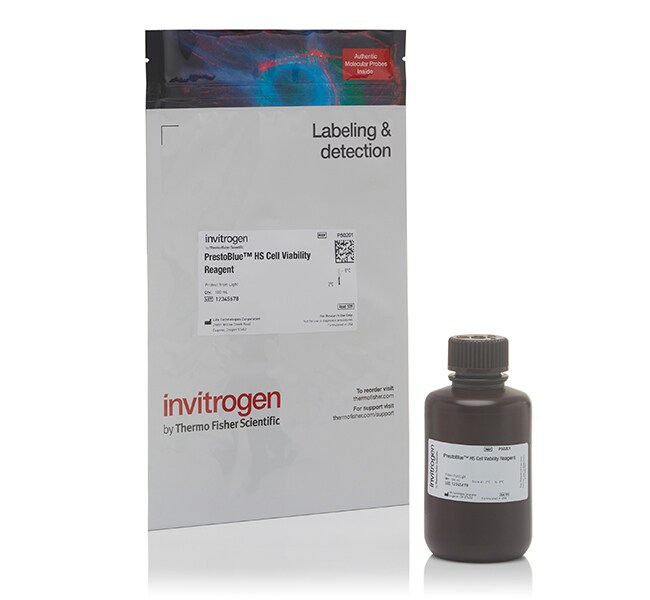Search

PrestoBlue™ and PrestoBlue™ HS Cell Viability Reagents
| Número de catálogo | Cantidad | Grado de pureza o calidad |
|---|---|---|
| P50201 | 100 ml | HS |
| A13261 | 25 mL | Estándar |
| A13262 | 100 mL | Estándar |
| P50200 | 25 ml | HS |
Measuring changes in cell viability is a fundamental method for assessing cell health, determining genotoxicity, and evaluating anti-cancer drugs. Cell health can be monitored by detecting changes in several key indicators, including changes to plasma membrane integrity, DNA synthesis, DNA content, enzyme activity, presence of ATP, and cellular reducing environment.
Features of PrestoBlue and PrestoBlue HS cell viability reagents include:
- Optimized for reliable detection of mammalian cell viability in only 10 minutes
- Measure cell viability and proliferation in various cell types, including mammalian (2D and 3D), bacteria, and yeast cells
- A convenient add-and-read format—no mixing, washing, or cell lysis required
- Compatible with either fluorescence- or absorbance-based microplate readers
- Obtain high quality cell proliferation results with a large dynamic range
- Monitor living cells using real time kinetics and continue culturing them for downstream multiplexed functional assays
Quick 10-minute incubations
Detect mammalian cell viability after just a 10-minute incubation with PrestoBlue and PrestoBlue HS cell viability reagents. These are the only live-cell viability reagents on the market that provide robust data in 10 minutes following reagent addition. All other resazurin-based cell viability reagents require a 1–4 hour incubation with the reagent prior to obtaining data. For best results using 3D samples, it is recommended to incubate the samples for 18–24 hours prior to measurements.
Exceptional sensitivity and accuracy
PrestoBlue and PrestoBlue HS cell viability reagents can detect as few as 12 cells per well in a 384-well plate, depending on the cell type and incubation time. After a 10-minute incubation, PrestoBlue reagent can linearly detect cells down to 98 cells/well with a Z' value greater than 0.5.
Simplified assay format
PrestoBlue and PrestoBlue HS cell viability reagents are addition-only reagents, eliminating the need for cell lysis or solubilization steps required by other assays. This minimizes hands-on time and simplifies the process.
Nontoxic live cell assays
PrestoBlue and PrestoBlue HS cell viability reagents are nontoxic and do not require cell lysis, allowing cells to be incubated for up to 24 hours. Since no lysis is required, the diluted PrestoBlue or PrestoBlue HS solution can be removed from the cells and replaced with complete growth medium for further culturing and use in downstream assays.
PrestoBlue HS reagent—a highly purified version of PrestoBlue reagent with improved performance
All resazurin-based reagents contain a detectable amount of resorufin contamination due to the synthesis and manufacturing process, which contributes to high background fluorescence and reduces performance in cell viability assays. To reduce background and improve performance, an innovative purification process was developed to remove the contaminating resorufin, resulting in the highly pure resazurin used in the PrestoBlue HS Cell Viability Reagent. This highly purified, nontoxic resazurin reduces background fluorescence by >50% and increases signal-to-background by >100% in cell viability microplate assays.
Features of PrestoBlue HS Cell Viability Reagent include:
- Removal of contaminants from resazurin, resulting in >50% reduction in background fluorescence
- Increased signal-to-background ratio by >100%, providing a large assay signal window
- Offers high sensitivity with a linear response, detecting as few as 10 cells per well
Mechanism of PrestoBlue and PrestoBlue HS reagents
Using resazurin-based reagents to monitor changes in cellular reducing environment or metabolic activity is a well-established and reliable method to indicate cell viability or death. PrestoBlue and PrestoBlue HS reagents contain resazurin, which is a nontoxic, cell permeable compound that is blue in color and virtually nonfluorescent. When added to cells, the resazurin-based PrestoBlue and PrestoBlue HS reagents enter cells and are modified by the reducing environment of viable cells. In live cells, resazurin is reduced to resorufin, a compound that is red in color and highly fluorescent. Viable cells continuously convert resazurin to resorufin, increasing the overall fluorescence of the medium surrounding the cells. The conversion of resazurin to resorufin also results in a pronounced color change, allowing cell viability to be detected using either absorbance- or fluorescence-based plate readers.
Para uso exclusivo en investigación. No apto para uso en procedimientos diagnósticos.